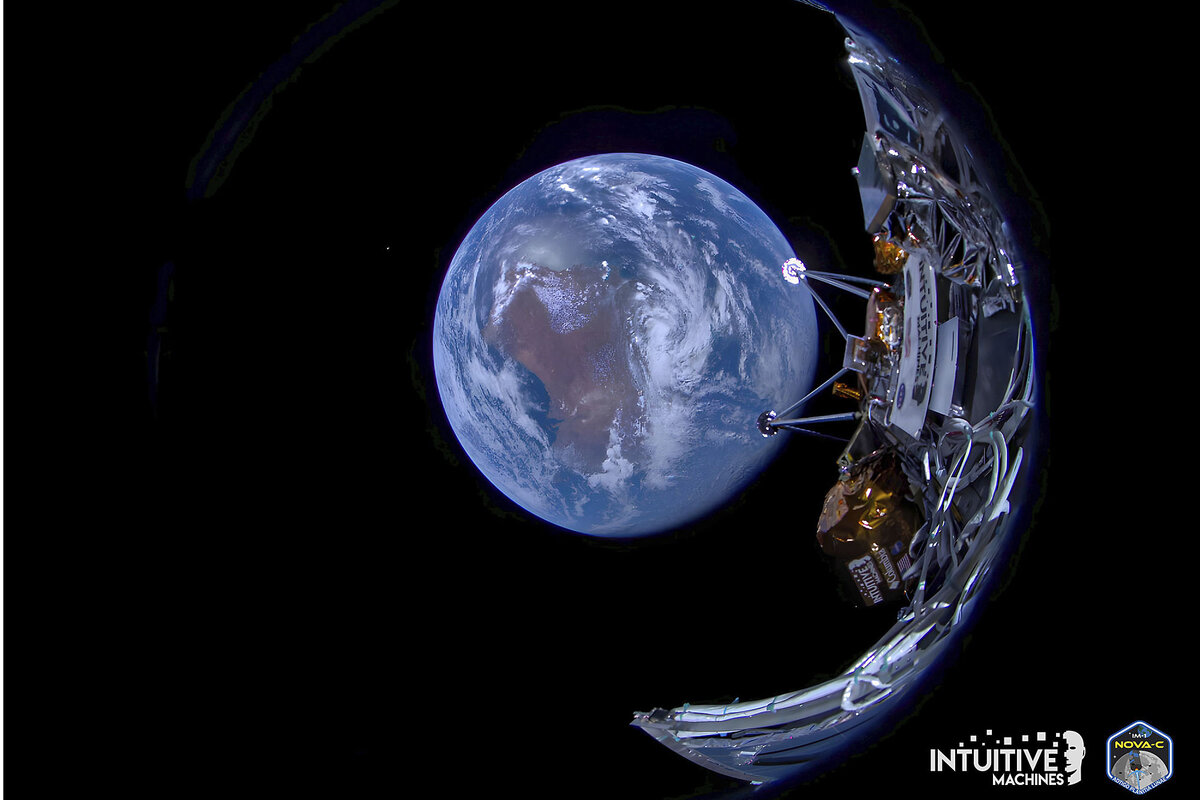US back on moon, with difficult landing for first private-sector craft
Loading...
More than 50 years after the last Apollo mission, an American spacecraft is back on the moon,ย marking the first lunar landing by any private company and a step toward the hoped-for return of humans to the lunar surface.
The uncrewed craft, nicknamed Odysseus or โOdieโ for short, touched down in the moonโs south pole region Feb. 22 at about 6:23 p.m. amid technical and communication challenges that arose.ย
On Friday morning the landerโs maker, Texas-basedย Intuitive Machines, posted on X (formerly Twitter) that โOdysseus is alive and well. Flight controllers are communicating and commanding the vehicle to download science data.โ But the company added that it was continuing to learn more about the craftโs โoverall healthโ and specific location. The vehicleโs solar power is working.
Why We Wrote This
The first lunar spacecraft landing by a private company is a milestone, even if technical challenges highlight the difficulty of space exploration.
Intuitive Machines reported that Odysseus tipped on its side during landing. On Feb. 27 the company said the lander has "efficiently sent payload science data and imagery in furtherance of the Companyโs mission objectives," but that battery power will likely run out on Feb. 28, earlier than hoped.
The arrival of such payloads โ Odie contains instruments and research experiments โย is seen by many as the next giant leap in an era of rising interestย in the moon and in commercial space exploration.ย
โIf these companies ... have developed new technologies that can be efficiently, inexpensively constructed, then the cost per flight will go down,โย says David Kring, principal scientist at the Lunar and Planetary Institute in Houston, where Intuitive Machines is headquartered. โAnd if the cost per flight goes down, then weโll be able to do greater science for the same amount of money.โ
Much has changed since 1972. Scientists have made huge technological advances. More nations are pursuing space exploration. And doors have opened for private companies to play a growing role in seeking lower-cost paths to success.ย
Failure is part of the journey, too. Three recent moon landing attempts by U.S., Russian, and Japanese companies flopped.ย
The Odysseus mission is one of several that NASA tapped Intuitive Machinesย to do, in a contract awarded three years ago. The craft was launched from the Kennedy Space Center aboard a SpaceX Falcon 9 rocket on Feb. 15.ย ย ย
Rising โlunar economyโ?
Key goals of this new era of exploration are to create what NASA calls a lunar economy, with projects and equipment that will โpave the way for a sustainable human presence on and around the moon,โ to Intuitive Machines. This mission is part of NASAโs Commercial Lunar Payload Services (CLPS) initiative and Artemis program, which has a long-term goal of establishing a permanent base on the moon. This would help pave the way for a human mission to Mars.
With decades having passed since the Apollo missions, scientists see plenty to do.ย
โWe have 50-plus years of questions,โ says Benjamin Greenhagen, a scientist with the Johns Hopkins Applied Physics Laboratory.ย ย
Odysseus separated from the launch rocket about a week ago. The lander ignited its engine about 18 hours into the flight and felt the moonโs gravitational pull once it covered the roughly 250,000-mile distance from Earth. Odysseusย aimed to touch down near the lunar feature called Malapert A, a relatively flat region in the otherwise heavily cratered area thatโs visible from Earth. Scientists are particularly interested in the little-explored south pole region and its water ice.ย
โWeโre going after scientific and technology studies that werenโt even envisioned back in the time of Apollo,โ said Joel Kearns, an official in NASAโs Science Mission Directorate, in a pre-touchdown press conference.ย ย
The aim is for theย lander to function on the moonโs surface for seven days, until lunar night falls, when it will be too cold to operate. Odysseus is a hexagonal cylinder with six legs, about 14 feet tall and 5 feet wide. Minus the legs, itโs roughly the size of a British telephone booth (an apt analogy for fans of โDoctor Whoโ).ย
Odysseus is the most recent creation in NASAโs Commercial Lunar Payload Services program, sponsoring private companies to build lunar landers. โIn CLPS, American companies used their own engineering and manufacturing practices instead of adherence to formal and traditional NASA procedures and NASA oversight,โ Mr. Kearns said in the briefing.ย
NASA paid Intuitive Machines around $118 million to carry out this lunar missionย and spent another $11 million to develop and build six instruments it put on the flight. A traditional NASA mission reportedly can cost around $500 million to $1 billion. The craft carried six NASA payloads and six commercial payloads โ scientific instruments or cargo โ to the moon.
From sculpture to radio-wave test
One key mission goal is toย evaluate the lunar environment with a radio receiver system and stereo camera system. Scientists are interested in measuring radio waves on the far side of the moon, the quiet side, which hasnโt been measured since 1973, says Dr. Kring.ย
โIf the far side is, in fact, radio quiet, and we are eventually able to deploy a radio telescope, we will be able to peer far deeper into the origin of the universe than any telescope has done in the past,โ he says.ย
The plan isnโt just for science experiments on the moonโs surface. The commercial payloads had hoped to deliver a commemorative sculpture by Jeff Koons. Some panels of the lander are insulated by material supplied by Columbia Sportswear to guard against the moonโs extreme temperatures.ย
Future steps may include rovers, attempts to have a craft survive the lunar night, or potentially hoppers that can explore hard-to-reach craters, says Mr. Greenhagen.ย
Perhaps the most important potential of missions like Odysseus is to kindle dreams for the next generation of astronauts.
โThe lunar spacecraft community has largely retired, ... so we needed to train and, through experience,ย developย a new generation of space explorers,โ says Dr. Kring. โNASAโs CLPS program and Intuitive Machinesโ successful landing are great first steps.โ
Editor's note: This story was updated on Feb. 27 with new information about the craft communicating after landing on its side, and the status of the sculpture by Jeff Koons.ย





